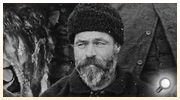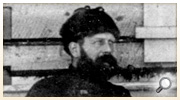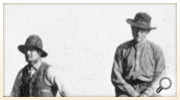
The Fortymile area lay within the traditional territory of the Hän. One group of Hän, the Tr’ondëk Hwëch’in, hunted, fished, trapped and gathered throughout the region; they also had a seasonal fish camp at the mouth of the Klondike. They were experienced traders, bartering and selling goods to other First Nations and to the white newcomers.
In the summer of 1896 the Yukon was still a district of the Northwest Territories, with its capital in Regina and its boundaries the source of an ongoing dispute with the United States. A few small trading posts were scattered along the Yukon River.

Brush shelters of the Hän at Tr’och’ëk, their traditional fish camp at the mouth of the Klondike River, 1895.
Yukon Archives, Coutts collection, 82/358 #2
A small number of miners had been at work in the Yukon since the late 1870s. Using basic hand-mining methods they prospected rivers, creeks and bars, trying to recover enough gold to sustain themselves for another season and hoping to make the big find that would make them rich.
Their numbers increased after September 1886, when coarse gold was discovered on the Fortymile River, the first such find in the Yukon. By the 1890s an estimated 1000 people — almost all of them men — were mining in the Yukon, mostly in the Fortymile area.
For fourteen months we heard no news from any person or place, except the news of the district around us.
William Ogilvie, 1887
A small community named Forty Mile developed at the mouth of the Fortymile River. It was remote from the rest of the world in a way that we can barely imagine, dependent for supplies on the long Yukon River route to St. Michael, Alaska, at the river’s mouth on the Bering Sea. The small sternwheelers on the river could usually make only one trip upstream from St. Michael each summer. Until the arrival of the first North-west Mounted Police contingent in 1895, as writer Pierre Berton observed, “it was really an American town, getting its supplies from the United States without customs payments and sending out mail with U.S. stamps.”
The summer of 1896 was so hot and dry that low water shortened the already limited navigation season. The productive ground at Forty Mile camp had all been staked, and the future of gold mining looked uncertain. Approximately 80 km upstream, however, was a small creek that would soon become a household word.

Gold is valued not only for its beauty but its constancy. The years just before the gold rush were beset by bank failures, a depression and currency devaluations. Gold was seen as stable and dependable.

William Ogilvie and his survey party at their winter quarters, October 1895. After the boundary survey it was discovered that most of the richest claims in the Fortymile region were not in Alaska, as miners had thought, but in Canada.
Libraries and Archives Canada, William Ogilvie fonds, C-074924

In 1895, the Yukon’s first NWMP post, Fort Constantine, was built at the mouth of the Fortymile River. Sgt. M.H.E. Hayne, shown here in 1895, was a member of the first detachment.
Yukon Archives, Strickland collection, #9404

In 1874, Fort Reliance was established in the traditional territory of the Tr’ondëk Hwëch’in, ten km downriver from the mouth of the Klondike River and across the Yukon River from the Hän village of Jutl’à’ K’ät (Nuklako). Sixtymile and Fortymile rivers were named for their distance from Fort Reliance.
Illustration drawn in 1884 by Willis Everette. University of Alaska Fairbanks, Dr. Willis Everette collection #1976-91

The North American Transportation and Trading Company (NAT&T) steamer Porteus B. Weare at the mouth of the Fortymile River, 1895. NAT&T established a post called Fort Cudahy (foreground) at the confluence of the Yukon and Fortymile rivers. The town of Forty Mile (seen in the distance) was just upstream.
Yukon Archives, Library and Archives Canada collection, 88/138 #12151

